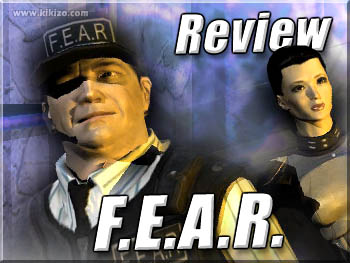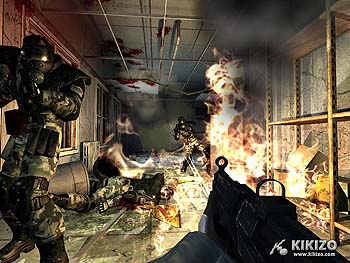F.E.A.R.
Stunning visuals and violent gameplay in Monolith's First Encounter Assault and Recon.
| Version PC | Developer Monolith Productions | Publisher Vivendi Universal | Genre FPS |
||||
Boom! A harsh thud heralds in a world of slow motion. My gun battle is turned into a graceful ballet, where my wits are my pas de deux and my shotgun is my pirouette. The gunfire from the soldier's rifle has turned into a series of pulsing thumps. As the crossfire elegantly flows around me I hover my sights over my assailant. Thud! As I pull the trigger my weapon's payload emerges from the barrel, leaving an alluring trail like a sky-bound firework. The lead strikes him clean in the chest. He is left helpless to his fate, locked in a winding back-flip of death, chips of concrete from the pillars discarded alongside him. I love this game.

F.E.A.R., which apparently stands for 'First Encounter Assault Recon', is the first-person shooter that everybody has had their eye on. The game puts you in the shoes of a rookie in an elite strike-team that deals with paranormal activities, so expect lots of ghouls and ghosts to scare the pants off you. Simply put, if Half-Life had a sordid love affair with System Shock, perhaps while two-timing with Eternal Darkness, we'd be left with a child something like F.E.A.R., obviously suffering from trauma caused by the father's unashamed womanising.
As we would expect from our regular trip down the bump-mapped corridors of the FPS, all the major features are present such as frantic multiplayer modes and graphics that bring our gaming PC to its knees. But there's more to this run and gun adventure than just pretty brickwork. The game sports a clever cinematic plot and some of the finest gameplay we've ever encountered in a shooter.
You lot don't fool us though; we know that you don't care about F.E.A.R.'s deep and meaningful personality, and all you're interested in are her suave good looks. Fortunately, this is a fine game to lust over; the ridiculous number of graphical effects going on at once is mind-blowing, the shadows and particle effects are among the best we've ever seen. On starting the game it will conveniently detect your computer's specs and enable the game's graphical bells and whistles based on how equipped your PC is for the job. Most likely, the game will beat the bruised and battered corpse of your PC hardware until you can cry no more, but turning off certain features in the options menu should give everyone a happy medium to run the game smoothly.
However, even more impressive than the visuals, is the enemy AI. While the game's enemies aren't yet smart enough to enslave mankind through oppressive cyborg shells, they're more than capable of giving us a good kicking through a mouse and keyboard. In a surprise attack from behind I knocked out a soldier, only to have the other soldiers knock furniture over for cover, an additional grunt dive through a window and a shiny grenade land between my feet. The AI is certainly among the most monumental we've seen this year. Some elements give off a suspicious aura of scripting but the many impressive dynamic encounters easily compensate.
The driver behind the wheel of the fun-mobile, cruising through F.E.A.R.'s dark and bloody corridors, is undoubtedly the Matrix-style slow-mo feature, which I so brilliantly nailed in the intro. With the tap of a button the game is transformed into an orchestra of sluggish bullets and flying kicks to the face. As sampled in previous titles like Max Payne and of course, reigning stinker Enter the Matrix, slow-motion gunplay can make things far easier on us when it comes to matters of several guards armed with sub-machine guns. But forget about past pretenders, this is the real master class of bullet-time. The graphical effects including the trails left by bullets and explosions are extremely impressive, especially in the multiplayer modes where things can get fairly chaotic. Simply put, there is nothing more fun than taking out a whole legion of soldiers with the frankly surgical power of a slow-motion shotgun.
F.E.A.R.'s array of weapons are part of a finely tuned balancing act that should not be underestimated. The player's weapon is what is used to interact with the world and as such its importance has been acknowledged in the design of the game. The shotgun, whilst excellent in close-quarters is expectedly tame when your foe is taking pot-shots at you from the other side of the room. Likewise a rifle is great for all-round blasting but lacks the pure stopping power and potential for disembowelment of our beloved boom-stick.
Jumping on the weapon management bandwagon, three slots are on hand to fill with various implements of death. In addition, as we all know how fun it is to blow things up - especially in slow motion - no FPS would be complete without a fine selection of grenades. However, the most interesting piece of F.E.A.R.'s twin-barreled puzzle is the many health and reflex expansions hidden throughout the game. We found this small inclusion adds a new layer of depth; we were always on the lookout for expansions sneakily hidden in the nooks and crevices of the game's drab locales.
While we're on the subject, we must admit that the environments in F.E.A.R. are one of the games most curious elements. Variety is almost non-existent and every cliché in the book has been thrown in for good measure, but we hardly noticed at all. The bleak backdrops further staple the tone of the game, F.E.A.R. doesn't try to barter new jungle levels or highway chases to the player, because boring, dark industrial office buildings work and we enjoy shooting concrete off of the walls whilst using furniture for cover - you can't do that in the jungle.
The great thing about dark corridors is it's really easy to scare the crap out of someone in them. We're sure you'd never have guessed, and we can reveal that F.E.A.R. is actually quite a scary game. You may call us wimps, but you see there's this little girl walking around - probably out thieving cars like any normal youth of today, except she's not actually real. Spooky, eh? The game's use of intelligent horror scare tactics impressed us way more than the generic monsters and zombies we're used to. The haunting throughout the game could start with a shadow, or a noise, but before you know it the walls are bleeding and a skeleton-man is trying to drown you. Did you imagine it? Probably - the main character is somewhat of a nutcase, but we were decidedly terrified anyway.
Leaving single player behind for a moment, we would like to cast our scrutinising verdict on F.E.A.R.'s luscious multiplayer mode. Somehow Monolith have managed to implement all of our favourite slow-motion mischief into the games online modes, and they've done this by envisioning it in the form of a power-up. The player with the sort out power-up wields the god-given powers of controlling time, but shockingly there is no trench-coat included. There were odd occasions when the utter slow-motion chaos erupting all-around left us totally awestruck, and often our PC passed out in the gutter.
So this is the part where we're supposed to tell you what's bad about the game, and to be honest there's not much. But we always come up with results here at Kikizo, and we've clutched at straws all day to bring you the following things to moan about. Firstly, with multiplayer still fresh in our minds we'd like to say that the maps aren't as sprawling as we would have liked, and sometimes the game engine tends to look a bit inferior to say the likes of Counter-Strike (which law dictates we must compare everything to). Also the single player game is a bit short, and it was too scary, and we wish the game came with a free pack of Chewits. We feel that these are all valid complaints.
We would perfectly describe F.E.A.R as the FarCry of 2005. We're sure some folks will love it, and some will hate it, but ultimately while being just a short distance away from genre superiority it is still a fantastic game. F.E.A.R. has everything going for it; a killer atmosphere, some of the most intense gun battles we've ever experienced and a satisfyingly immersive narrative. Extra bonus points for the minimum use of explosive barrels.
| ||||||||||||
|

























 Satoru Iwata Video Interview - the late Nintendo president spoke with Kikizo in 2004 as 'Nintendo Revolution' loomed.
Satoru Iwata Video Interview - the late Nintendo president spoke with Kikizo in 2004 as 'Nintendo Revolution' loomed. Kaz Hirai Video Interview - the first of Kikizo's interviews with the man who went on to become global head of Sony.
Kaz Hirai Video Interview - the first of Kikizo's interviews with the man who went on to become global head of Sony. Ed Fries Video Interview - one of Xbox's founders discusses an epic journey from Excel to Xbox.
Ed Fries Video Interview - one of Xbox's founders discusses an epic journey from Excel to Xbox. Yu Suzuki, the Kikizo Interview - we spend time with one of gaming's most revered creators.
Yu Suzuki, the Kikizo Interview - we spend time with one of gaming's most revered creators. Tetris - The Making of an Icon: Alexey Pajitnov and Henk Rogers reveal the fascinating story behind Tetris
Tetris - The Making of an Icon: Alexey Pajitnov and Henk Rogers reveal the fascinating story behind Tetris Rare founders, Chris and Tim Stamper - their only interview? Genuinely 'rare' sit down with founders of the legendary studio.
Rare founders, Chris and Tim Stamper - their only interview? Genuinely 'rare' sit down with founders of the legendary studio. The History of First-Person Shooters - a retrospective, from Maze War to Modern Warfare
The History of First-Person Shooters - a retrospective, from Maze War to Modern Warfare